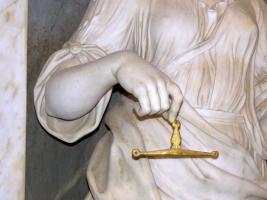
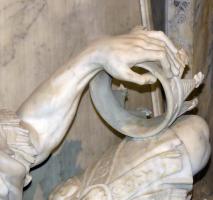
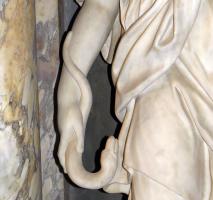
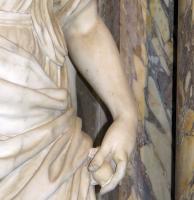
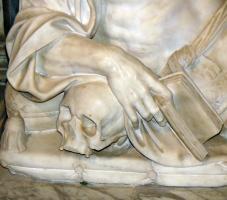
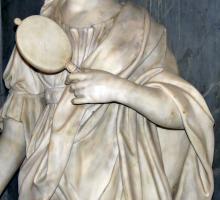
The monument to Richard Ladbroke, d.1730, in St Mary Magdalene Church, Reigate, is a large architectural structure with figure sculpture, in different marbles in the grandest 18th Century style. The monument as a whole is in the shape of a Baroque triumphal arch, or the front part thereof, raised up on a broad altar-tomb or sideboard like structure to give a base to the pillars and principal figures. The statue of Richard Ladbroke reclines Roman fashion in the centre, and behind him, flat against the black backing is a tall pyramid or obelisk with a coat of arms on top, and bearing the inscription - he died in 1730, and added text commemorates his family through to 1793, plus undated offspring. To each side, pairs of Corinthian pillars support the main superstructure, being a broken, curved pediment, with statues of allegorical girls seated on the sides, and a raised central portion enclosing a roundel carved with winged cherub heads surrounded by a sunburst. Above all this is a small roof on which rest two unclothed cherubs beside a central flaming urn. So all of this forms the central portion of the monument. To the sides are two recessed wings, the outer ‘doorways’ of the arch. Each of these has an outer pilaster (flat pillar), and a standing allegorical girl, Classical baroque, providing suitable companion figures for the central figure of Richard Ladbroke. Above, on the entablature, are pots or urns.
Richard Ladbroke monument, and principal group.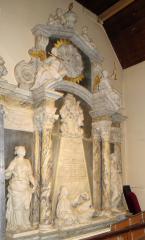
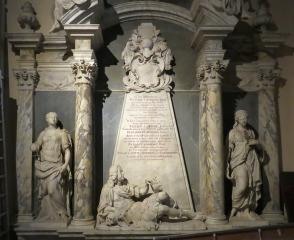
The statue of Richard Ladbroke reclines easily leaning on one elbow, that hand holding a book, with a finger inserted to mark his page; his other hand holds a crown with stars which rests above the knee of one leg, which is raised; the front leg is less raised, and the overall pose is both relaxed, and the prelude to movement; this statue is of a living person, a far cry from the ‘sleeping in death’ figures found in previous generations of tomb sculpture - for example the Bludder and Elyott monuments also in Reigate Church. The only symbol of death in the Ladbroke monument, that tucked under one hand of the figure, is a nicely-carved skull, a memento mori of monuments a century before. Ladbroke is dressed Roman style, in a military toga, with bare legs above strapped sandals – the note of incongruity is his curly hair hanging to his shoulders, a wig of his own time, and the crown of course is also out of place. The carving is excellent, most particularly the humourless but intelligent face, and the muscular legs and sensitive hands.
Statue of Richard Ladbroke, and detail of portrait.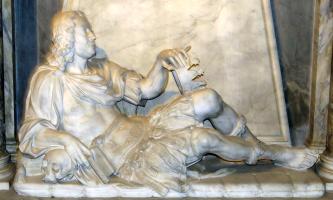
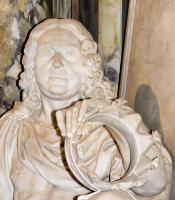
The full sized statues of allegorical girls to left and right are Justice on the left and Truth on the right. Justice holds the remains of her scales, and with her other hand gathers up her thick robes; she also appears to be holding some small rotund object. Her Classical drapery consists of a light chiton (thin shift) underneath, with short tied up sleeves to reveal her smooth youthful arms; over this she has a robe, at her back and then swept round to form an elegant mass of drapery. Her face is ideal, in an 18th Century rather than ancient Greek manner, and her hair is caught up at the back with a few coils down to her shoulders, to show her smooth neck. The drapery is carved beautifully and is elegantly disposed about her body, which is nicely twisted, with legs somewhat to the left, a graceful turn to the torso, and the head looking to the right. For a variety of Justice statues, see this page. The allegorical statue of Truth is better still. Her pose is walking forward, head turned a little to one side and lowered, one hand holding her mirror, common symbol of Truth, and the other, a snake, which wraps itself around her lower arm and turns its head upwards; such a snake is often indicative of Wisdom (For examples of snake sculpture, see this page, and for allegorical figures of Truth, see this page). The figures of Justice and Truth are matched, and their faces are similar, yet for variety, the drapery on the statue of Truth is far simpler than on her sister, forming larger folds and masses around her. Both figures are barefoot.
Justice and Truth, full sized allegorical statues.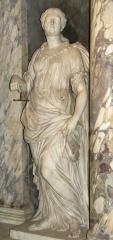
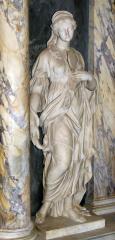
Up above are our angel statues, reclining on the edges of the central structure. They are dressed somewhat similarly but rather more loosely to the allegorical figures standing beneath. The one on the right has a trumpet, no longer held as her hand is damaged. They are simpler in treatment but still fine. At the top, the plump cherubs, each fat little body resting on a tasselled cloth, are good of their type. More examples of Angel sculpture on this page, and if you must have cherubs, see this page.
Upper portion of the monument, and views of the angels.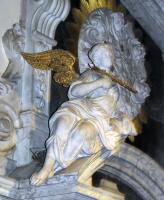
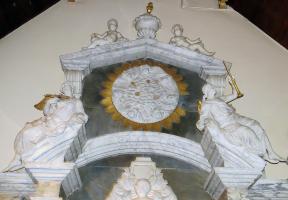
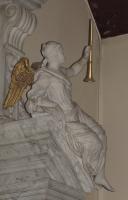
Altogether, the Ladbroke monument is a most magnificent ensemble, which I would think is equal in the quality of the figure sculpture to the statues in the national museums, and the only shame is that it stands in a side chapel of the Church and the viewer cannot get far enough away from in front to have the ideal view. The sculptor, Joseph Rose the Elder, is known for only one other grand monument, and also worked as a maker of ornamental plaster, as did his nephew, Joseph Rose the Younger, and others in the family.
For the other monuments in St Mary's Reigate, see this page. This website includes notes and pictures of a variety of monuments, particularly in London churches, accessible from the lists on this page for City churches and this page for other London churches; another 'reclining Noble Roman' tomb of the 18th Century is that to the Earl of Shelburne and his wife Arabella in High Wycombe Church - a full description is on this page.
With many thanks to the Church authorities for permission to show pictures from inside the St Mary's: their website is at http://www.stmaryreigate.org/our-buildings/.
This page was originally part of a 'sculpture of the month' series, for April 2016. Although the older pages in that series have been absorbed within the site, if you would wish to follow the original monthly series, then jump to the next month (May 2016) or the previous month (March 2016). To continue, go to the bottom of each page where a paragraph like this one allows you to continue to follow the monthly links.
Sculpture in some towns in England // Introduction to church monuments
Visits to this page from 1 Apr 2016: 4,742